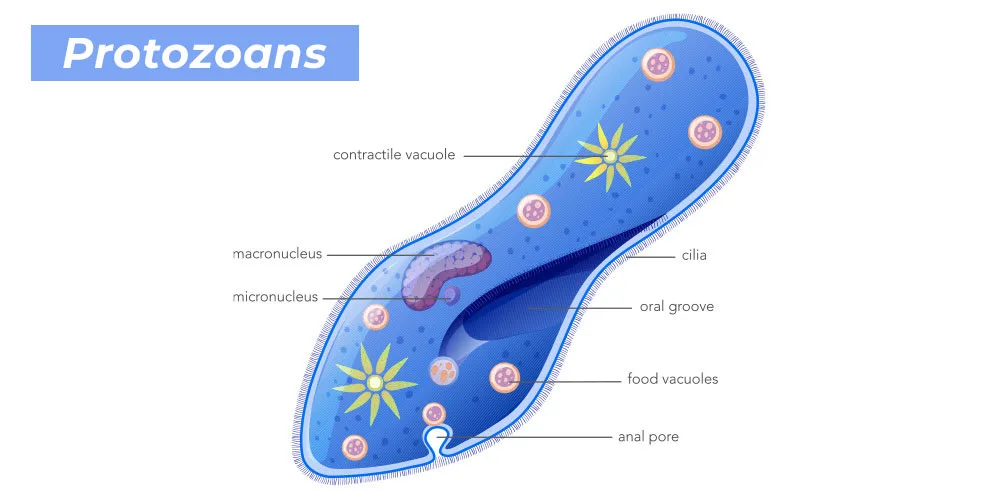
Protozoa Definition: Protozoa are tiny living organisms composed of just one cell. They require a microscope for observation due to their tiny size. They inhabit various environments, such as water bodies, soil, and even the bodies of other organisms. Despite their small size, they show multiple shapes and sizes.
Protozoa use diverse movement methods; some use tiny hairs, while others alter their shape to navigate their surroundings. They feed on tiny organisms like bacteria and algae, and certain species can act as parasites, living inside other organisms and causing illness. Reproduction methods vary among protozoa. Some experience binary fission, splitting into two identical organisms, while others engage in genetic exchange before dividing. Protozoa play crucial roles in ecosystems that contribute to the food chain and maintain ecological balance. Though some species can be problematic, most fulfill their roles quietly, contributing to the natural order without causing harm.Protozoa Diagram
The following is a diagram of Protozoa :
Protozoa Classification
Protozoa are a diverse group of microscopic organisms classified into several species or groups based on their characteristics. The main classifications of protozoa include:- Sarcodina (or Rhizopoda) : This group comprises amoebas, which move by extending parts of their cell called pseudopodia. Amoebas are often found in freshwater, marine environments, and soil.
- Mastigophora (or Zoomastigophora) : Mastigophorans are characterized by having flagella, which they use for movement. Examples include Giardia lamblia and Trypanosoma, which can cause human diseases.
- Ciliophora : Ciliates are protozoa with hair-like structures called cilia that they use for movement and feeding. Paramecium is a well-known example of a ciliate.
- Apicomplexa (or Sporozoa) : Apicomplexans are often parasitic and have complex life cycles. Significant examples include Plasmodium, the parasite responsible for malaria, and Toxoplasma, which causes toxoplasmosis.
- Microspora : Microsporans are intracellular parasites known for their unique features, like polar tubes, which they use to infect host cells.
- Coccidia : Coccidia are a subclass of Apicomplexans that commonly infect the intestinal tract of animals, including humans.
Protozoa Characteristics
Protozoa are a diverse group of microscopic, single-celled organisms in the Protista kingdom. Here are some essential characteristics of protozoa:- Unicellular : Protozoa comprise a single cell, unlike multicellular organisms, which contain many cells.
- Eukaryotic : Protozoa have complex cells with membrane-bound organelles, including a nucleus that houses their genetic material.
- Microscopic : Most protozoa are too small to be seen with the naked eye and require a microscope for observation.
- Mobility : Many protozoa can move, which they achieve through structures such as flagella, cilia, or pseudopodia.
- Heterotrophic : Protozoa are generally heterotrophic, which means they obtain their nutrients by ingesting organic matter or other organisms. They can be phagotrophic (feeding by engulfing food particles) or osmotrophic (feeding by absorbing dissolved organic substances).
- Reproduction : Protozoa reproduce asexually through binary fission, where the cell divides into two identical daughter cells, or through multiple fission, where one cell divides into several daughter cells. Some protozoa also reproduce sexually, involving processes such as conjugation.
- Habitats : Protozoa are found in a wide range of habitats, including freshwater, marine environments, soil, and the bodies of other organisms. They can thrive in diverse conditions, from extreme temperatures to acidic environments.
- Ecological Roles : Protozoa play essential roles in various ecosystems as consumers of bacteria and other microorganisms and as part of the food chain for larger organisms. Some species are parasitic and cause human, animal, and plant diseases.
- Diversity : Protozoa show tremendous diversity in size, shape, structure, and lifestyle. They are classified based on movement mode and other characteristics, including amoebas, flagellates, ciliates, and sporozoans.
| Other NEET Biology Topics | ||
|---|---|---|
| Ribosomes | Pollination | Apomixis |
| Centrosome | Embryo | Tissues |
| Rhizopus | Pinus | Gluconeogenesis |
| Chlamydomonas | Chara | Ribs |
Function Of Protozoa
Despite being very small, Protozoa significantly impact different ecosystems. These tiny creatures comprise just one cell but do many important jobs that help keep nature balanced and working well. Even though they're simple, protozoa are essential for moving nutrients around, passing energy along, controlling germs, working with other creatures, and managing environmental pests. The functions of Protozoa are given below.- Decomposition : Protozoa help break down dead organic matter, such as plant and animal remains, into simpler substances. This process aids in recycling nutrients back into the environment.
- Nutrient Recycling : By consuming bacteria and other microorganisms, protozoa release essential nutrients like nitrogen and phosphorus. These nutrients become available for plant uptake, completing a vital cycle of nutrient recycling.
- Role in Food Chains : Protozoa is a primary food source for many tiny aquatic organisms, including fish and crustaceans. They are essential in sustaining food webs by transferring energy from lower to higher trophic levels.
- Microbial Regulation : Certain protozoa target harmful bacteria, regulating their populations in ecosystems. This helps maintain a balanced microbial community and prevents the overgrowth of potentially harmful microorganisms.
- Symbiotic Relationships : Protozoa engage in symbiotic associations with other organisms. For instance, they assist in digesting complex plant material in the guts of animals like termites, contributing to mutualistic relationships.
- Biological Pest Management : Some protozoa are utilized as biological control agents to manage pest populations. They can be introduced into environments to target specific pest species, providing a natural and sustainable approach to pest management.
Protozoa Examples
Protozoa are single-celled organisms often overlooked due to their microscopic size, but they play significant roles in various ecosystems. Despite their simplicity, protozoa perform diverse functions that contribute to the balance and functioning of natural environments. From nutrient cycling to microbial regulation, protozoa are essential components of ecosystems. Here are 10 examples of protozoa, each with its unique characteristics:- Amoeba : It is a common protozoan that moves by extending its cell membrane to form pseudopods, enabling it to engulf food particles.
- Paramecium: It is a ciliated protozoan with hair-like structures called cilia that it uses for movement and feeding.
- Euglena : It is a flagellated protozoan that moves using a whip-like tail called a flagellum and can also perform photosynthesis.
- Giardia lamblia : It is a parasitic flagellate that infects the intestines of animals, including humans, causing a diarrheal illness called giardiasis.
- Trypanosoma : It is another parasitic flagellate responsible for diseases like African sleeping sickness and Chagas disease.
- Plasmodium : It is a sporozoan parasite transmitted by mosquitoes, causing malaria in humans and other animals.
- Toxoplasma gondii : It is a parasitic sporozoan known for causing toxoplasmosis, which can be harmful to pregnant women and individuals with weakened immune systems.
- Balantidium coli : It is a ciliated protozoan parasite found in the intestines of humans and other animals, causing a disease called balantidiasis.
- Trichomonas vaginalis : It is a flagellated protozoan responsible for causing the sexually transmitted infection trichomoniasis.
- Entamoeba histolytica : It is an amoeboid protozoan parasite that can cause amoebic dysentery, a severe form of diarrhoea, in humans.
Protozoa and Paramecium
Protozoa are a diverse group of single-celled organisms that play significant roles in various ecosystems. Despite their microscopic size, they significantly impact the balance and functioning of natural environments. Paramecium is a specific type of protozoa known for its unique characteristics and serves as an example of the diversity within this group. Paramecium is a member of the ciliate group of protozoa, characterized by its elongated shape and numerous hair-like structures called cilia. These cilia enable Paramecium to move and feed efficiently. Meanwhile, protozoa encompass various organisms with varying structures and behaviours. Paramecium stands out due to its specialized adaptation for movement and feeding. The complete differences between protozoa in general and Paramecium specifically:| Difference Between Protozoa and Paramecium | ||
|---|---|---|
| Characteristic | Protozoa | Paramecium |
| Classification | It is a broad category that includes many different single-celled organisms. | It is a specific type belonging to the ciliate group. |
| Structure | It varies depending on the type of protozoa, ranging from simple to complex. | It has an Elongated shape with numerous cilia for movement and feeding. |
| Movement | It can use different methods, such as flagella, cilia, or pseudopodia. | It Primarily moves using cilia. |
| Feeding | It feeds on bacteria, other microorganisms, or organic matter. | It feeds on bacteria and tiny organisms by sweeping them with cilia. |
| Habitat | It is found in diverse habitats, including freshwater, marine environments, and soil. | It is often found in freshwater environments. |
| Reproduction | It can reproduce asexually or sexually, depending on the species. | It reproduces asexually by binary fission. |
| Importance in Ecosystems | It is essential in nutrient cycling, energy transfer, and microbial regulation. | It serves as prey for various microorganisms and small animals in freshwater ecosystems. |
| NEET Exam Important Links | |
|---|---|
| NEET Biology Syllabus | NEET Biology Diagrams |
| NEET Biology MCQ | NEET Biology Chapter wise Weightage |
| NEET Biology Notes | NEET Previous Year Question papers |
Protozoa FAQs
Which kingdom do protozoa belong to?
Protozoa are part of the Protista kingdom, consisting of single-celled eukaryotic organisms. They live in various environments, from freshwater to parasitic habitats.
What are protozoa?
Protozoa are single-celled organisms found worldwide in various environments. While most are independent, some can cause diseases in other animals, leading to various health problems.
Are protozoa considered diseases?
Yes, protozoa have the potential to cause diseases. Common examples include malaria, giardiasis, and toxoplasmosis. Diagnosis usually involves medical tests such as blood tests, stool tests, or biopsies to identify the specific parasite responsible.
Who is known as the "father of bacteria"?
Antonie van Leeuwenhoek is widely recognized as the pioneer of microbiology. He made significant contributions to the field by being the first to observe protists and bacteria using his groundbreaking microscopes.
Is Euglena classified as a protozoan?
Yes, Euglena is classified as a protozoan. It is a single-celled organism possessing two flagella, one visible under a light microscope.
🔥 Trending Blogs
Talk to a counsellorHave doubts? Our support team will be happy to assist you!

Check out these Related Articles
Free Learning Resources
PW Books
Notes (Class 10-12)
PW Study Materials
Notes (Class 6-9)
Ncert Solutions
Govt Exams
Class 6th to 12th Online Courses
Govt Job Exams Courses
UPSC Coaching
Defence Exam Coaching
Gate Exam Coaching
Other Exams
Know about Physics Wallah
Physics Wallah is an Indian edtech platform that provides accessible & comprehensive learning experiences to students from Class 6th to postgraduate level. We also provide extensive NCERT solutions, sample paper, NEET, JEE Mains, BITSAT previous year papers & more such resources to students. Physics Wallah also caters to over 3.5 million registered students and over 78 lakh+ Youtube subscribers with 4.8 rating on its app.
We Stand Out because
We provide students with intensive courses with India’s qualified & experienced faculties & mentors. PW strives to make the learning experience comprehensive and accessible for students of all sections of society. We believe in empowering every single student who couldn't dream of a good career in engineering and medical field earlier.
Our Key Focus Areas
Physics Wallah's main focus is to make the learning experience as economical as possible for all students. With our affordable courses like Lakshya, Udaan and Arjuna and many others, we have been able to provide a platform for lakhs of aspirants. From providing Chemistry, Maths, Physics formula to giving e-books of eminent authors like RD Sharma, RS Aggarwal and Lakhmir Singh, PW focuses on every single student's need for preparation.
What Makes Us Different
Physics Wallah strives to develop a comprehensive pedagogical structure for students, where they get a state-of-the-art learning experience with study material and resources. Apart from catering students preparing for JEE Mains and NEET, PW also provides study material for each state board like Uttar Pradesh, Bihar, and others
Copyright © 2025 Physicswallah Limited All rights reserved.
Get App









